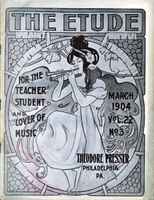BY D. A. CLIPPINGER.
Owing to a very elastic nomenclature all statements relative to the voice need explanation. Such a variety of terms is used in referring to the different vocal processes that it is often impossible to make a bare statement with any assurance of conveying an exact meaning.
In speaking of the head voice it is necessary to explain what is meant. Take, for example, the pitch G, fourth space, bass clef. One may sing half a dozen different qualities without in any way changing the action of the vocal chords. This is the result of different formations of the cavities above the vocal chords. The slightest change in the formation of the cavities will affect the quality or color of the tone. All of these qualities may be produced with a full power or they may be produced pianissimo. This can be done in any part of the voice, while the singer may have all the shades of tone color, from the very bright to the very somber, in any of the so-called registers and at any power. Tone color then is in nowise a question of register or power. It comes under the head of voice placing, by which is meant an adjustment of the cavities above the vocal chords.
Is the head voice, then, as the term applies to the male voice, a matter of voice placing, that is, tone coloring, or is it the result of a different mechanism, a different action of the vocal chords? If it is true that every variety of tone color may be produced on any tone of the voice, then we should look elsewhere for a solution of the most difficult problem in developing the male voice, namely, what to do with the upper end of it.
Tenors with fresh, brilliant voices sing A and B-flat with great power and resonance, and a great career is predicted; but after a few years the upper voice loses its brilliancy. The tones become veiled and husky and are taken with great effort, and finally disappear one by one. What is the cause? We may discover it if we recognize the fact that male and female voices do about the same things at the same absolute pitches.
To go back for a moment. The boy's voice, before it changes, is in the same compass and is produced in the same way as the adult female voice. What occurs when the boy's voice changes? He adds a heavier part to the lower end of it, and from that time on that which was his boy's voice is termed falsetto. Like every organ or faculty, from lack of use, it deteriorates and is considered worthless. And the tenor proceeds to push his thick chest voice up to G, A, or even B-flat, with the results already described.
What would result if a soprano or alto should sing chest tones as high as A or B-flat? It is hardly necessary to answer, as it is generally known that it means destruction to the voice. The part above the chest voice would become so weak as to be useless, and sooner or later even the upper chest tones would disappear.
When the tenor sings A or B-flat above the staff he is singing the same absolute pitches as those the soprano sings when represented by the treble clef, second space, and third line. That which happens to the soprano or alto who forces the chest voice up to A or B-flat happens also to the tenor. And the thing which will preserve the soprano or alto will preserve the tenor.
The female voice should cultivate that which is known as the medium or middle register, carrying it down as low as D in the space below or even lower. It is not unusual to find sopranos who have no chest register. In such cases the middle register is developed to the bottom of the voice and takes the place of the chest voice. This middle register in the female voice is identically the same as the boy's voice before the change, and what is known afterward as falsetto. Garcia, in his "Vocal Method," calls the middle register of the female voice falsetto.
But it is urged that the middle register of the female voice is much stronger than the male falsetto. Very true; because the female voice uses the middle register continually, both in speaking and singing. It is to this that it owes its power. The male falsetto is rarely used. It would be remarkable indeed if the middle register of the female voice were not the stronger. If the male falsetto were used to an equal extent it would not be lacking in strength.
The falsetto has been misunderstood by many, and its use has been avoided. It has been looked upon as an effeminate quality, and judged by that standard there can be no difference of opinion as to its merits, but if we look upon it as a mechanism, an adjustment by means of which a superior quality of chest voice may be developed, then it becomes a different matter.
If the tenor would produce his upper voice with ease then he must in some way learn to release it. Like the piano he must use a lighter string. This may be easily secured, not by carrying a thick tone up, but by carrying a lighter tone down.
The thick vibration used by so many voices soon becomes harsh and unsympathetic. This lighter adjustment, call it falsetto for want of a better name, can be cultivated almost to the lowest range of the voice, and results in a chest quality that is rich and sympathetic and insures an ease in the production of the upper voice that can be secured in no other way. That this can be done has been demonstrated to my perfect satisfaction.



